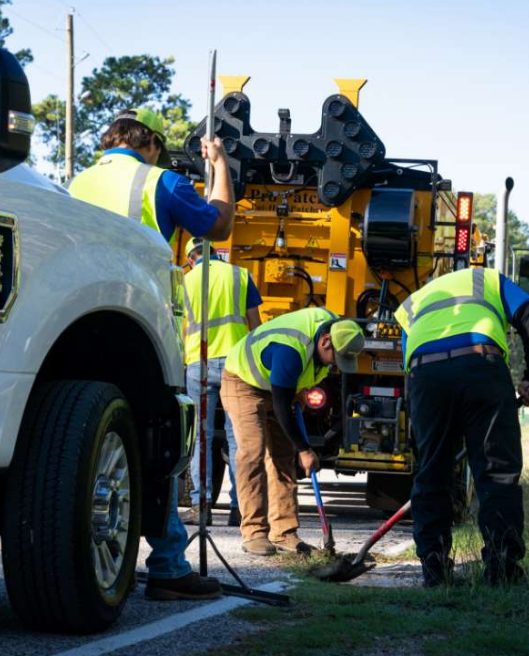- Sections :
- Crime & Public Safety
- Restaurants & Food
- Sports
- More
Categories
Montgomery County update on drainage and flood mitigation

THE WOODLANDS, TX -- In response to recent comments questioning Montgomery County efforts to improve drainage and flood mitigation, the Precinct 3 Commissioner’s Office wanted to inform our constitiuents of the efforts already undertaken by Commissioners Court, Montgomery County Engineering Department and the Office of Emergency Management. The collective efforts of all entities have resulted in changes in drainage criteria, funding for infrastructure projects, property buyouts, and investments in studies. These changes allow for long-term solutions to flood issues in the isolated areas that have experienced hardships over the past several rainfall events.
Some of those efforts include:
• Montgomery County was a leader in upgrading regulations on development, becoming one of the first communities in Texas to adopt the new Atlas 14 standards. Commissioners voted in October 2018 to implement the new standards, which went into effect Jan. 1, 2019, and were amended in the Montgomery County Drainage Criteria Manual. This is for drainage criteria analysis and design of detention ponds, taking into account the new 100-year flood event rainfall rate of 16 inches per 24-hour period vs. the old rate of 12 inches per 24-hour period.
• In addition, at that same time in 2018, county commissioners authorized the Engineering Department to update the Drainage Criteria Manual. The Engineering Department is monitoring the ongoing flood mitigation studies and will use the information and data from these studies, along with additional research, to ensure effective changes to the manual.
• The county has secured $36 million in grant funds for buyouts of homes with severe and repetitive loss from floodwater. That should cover around 100 homes.
• The county is utilizing $12.5 million of Community Development Block Grant-Disaster Recovery funds from HUD on two flood mitigation programs that address five areas, including Tamina, Allendale, River Oaks, Porter Heights and South Porter.
• The county has applied for funding to cover two infrastructure projects, including one that would directly benefit residents in The Woodlands – a Sawdust bridge project that would provide access into and out of the flood-prone areas of Grogan’s Point and Timber
Lakes/Timber Ridge in the aftermath of major rainfall events. The other project is in East Montgomery County (Grand Parkway/FM 1314 area).
• The county also formed a work group involving representatives from all four precincts and other vital county departments to discuss future drainage projects and flood mitigation, with a goal of seeking and obtaining funding for the identified projects.
• The county has invested $259,262 in two regional floodplain and drainage studies in partnership with other responsible government agencies and entities.
o Upper West Fork of the San Jacinto Flood Protection Planning study (Phase 1), at a cost
of $90,000 to Montgomery County:
? Updates the modeling of the West Fork San Jacinto River upstream of Interstate 45.
? Identifies number of structures and roads “at risk” at various water levels/flood stages.
? Identifies mitigation opportunities and provides a cost-benefit ratio for each proposal to determine feasibility.
? Preliminary report issued in February 2019; and final report is under review.
? San Jacinto River Authority and City of Conroe partnered with Montgomery County on this project.
o San Jacinto Regional Watershed Master Drainage Plan at a cost of $169,262.98 to
Montgomery County.
o Study of all regional watersheds, including Spring Creek:
? Develop non-regulatory inundation maps for the studied streams, showing extent and depth of flooding of larger rivers within the watershed for various storm events.
? Identifies number of structures, acres of land, properties and miles of roads within the modeled floodplains.
? Data will be used to update hazard mitigation plans for participating partners and provide guidance on regulations for future growth within the study area.
? Study will identify future flood mitigation projects for near- and long-term solutions to reduce flood risks to people and property.
? Develops approaches to enhance public information and flood-level assessment capabilities during flood disasters.
? Provides a comprehensive Flood Mitigation Plan that supports the needs and objectives of the regional partners.
? Study uses Atlas 14 rainfall standards and started in April 2019.
? Harris County Flood Control District, City of Houston and San Jacinto River Authority partnered with Montgomery County on this project FEMA Hazard Mitigation Planning Program is funding 75 percent of this study, with the four local entities splitting the other 25 percent.
Montgomery County supports the other studies being funded by such entities as the municipal utility districts in The Woodlands and Harris County. These studies and the vital information obtained do not occur overnight; and all community leaders and residents must understand that any solution will require substantial time and funding.
Residents – and community leaders – must understand that the 500-year, plus 2 feet design standards adopted in Harris County have no impact on drainage. This only potentially protects the new structures in certain major flooding events. The topography in most of Montgomery County is much different than the flatter areas in Houston/Harris County. Developing such an across-the-board design standard may not be needed in most of Montgomery County and ultimately could fall short in other areas.
Most of the homes in Montgomery County that endure repetitive loss during storm events were constructed prior to the first FEMA floodplain maps in 1984 and prior to the initial county drainage criteria manual in 1989. These homes will continue to flood, no matter any changes to elevation requirements.
In addition, roads are constructed to hold rainwater, especially in major storm events. High water on roads for a short period of time only means the rainfall at that particular location for a certain period of time exceeded the design for rainfall frequency on that specific road, which varies from 25-year frequency on open-ditch thoroughfares down to three-year frequency for curb-and-gutter minor streets. In major storm events, residents should stay off the roads, if at all possible, until the storm and rainwater subside.
Montgomery County will continue our work toward drainage and flood mitigation solutions, as well as updates to the Drainage Criteria Manual and Flood Plain Management Regulations, including any necessary changes minimum slab elevations.
For more information or with any other questions, please contact Evan Besong at 281-367-3977
Some of those efforts include:
• Montgomery County was a leader in upgrading regulations on development, becoming one of the first communities in Texas to adopt the new Atlas 14 standards. Commissioners voted in October 2018 to implement the new standards, which went into effect Jan. 1, 2019, and were amended in the Montgomery County Drainage Criteria Manual. This is for drainage criteria analysis and design of detention ponds, taking into account the new 100-year flood event rainfall rate of 16 inches per 24-hour period vs. the old rate of 12 inches per 24-hour period.
• In addition, at that same time in 2018, county commissioners authorized the Engineering Department to update the Drainage Criteria Manual. The Engineering Department is monitoring the ongoing flood mitigation studies and will use the information and data from these studies, along with additional research, to ensure effective changes to the manual.
• The county has secured $36 million in grant funds for buyouts of homes with severe and repetitive loss from floodwater. That should cover around 100 homes.
• The county is utilizing $12.5 million of Community Development Block Grant-Disaster Recovery funds from HUD on two flood mitigation programs that address five areas, including Tamina, Allendale, River Oaks, Porter Heights and South Porter.
• The county has applied for funding to cover two infrastructure projects, including one that would directly benefit residents in The Woodlands – a Sawdust bridge project that would provide access into and out of the flood-prone areas of Grogan’s Point and Timber
Lakes/Timber Ridge in the aftermath of major rainfall events. The other project is in East Montgomery County (Grand Parkway/FM 1314 area).
• The county also formed a work group involving representatives from all four precincts and other vital county departments to discuss future drainage projects and flood mitigation, with a goal of seeking and obtaining funding for the identified projects.
• The county has invested $259,262 in two regional floodplain and drainage studies in partnership with other responsible government agencies and entities.
o Upper West Fork of the San Jacinto Flood Protection Planning study (Phase 1), at a cost
of $90,000 to Montgomery County:
? Updates the modeling of the West Fork San Jacinto River upstream of Interstate 45.
? Identifies number of structures and roads “at risk” at various water levels/flood stages.
? Identifies mitigation opportunities and provides a cost-benefit ratio for each proposal to determine feasibility.
? Preliminary report issued in February 2019; and final report is under review.
? San Jacinto River Authority and City of Conroe partnered with Montgomery County on this project.
o San Jacinto Regional Watershed Master Drainage Plan at a cost of $169,262.98 to
Montgomery County.
o Study of all regional watersheds, including Spring Creek:
? Develop non-regulatory inundation maps for the studied streams, showing extent and depth of flooding of larger rivers within the watershed for various storm events.
? Identifies number of structures, acres of land, properties and miles of roads within the modeled floodplains.
? Data will be used to update hazard mitigation plans for participating partners and provide guidance on regulations for future growth within the study area.
? Study will identify future flood mitigation projects for near- and long-term solutions to reduce flood risks to people and property.
? Develops approaches to enhance public information and flood-level assessment capabilities during flood disasters.
? Provides a comprehensive Flood Mitigation Plan that supports the needs and objectives of the regional partners.
? Study uses Atlas 14 rainfall standards and started in April 2019.
? Harris County Flood Control District, City of Houston and San Jacinto River Authority partnered with Montgomery County on this project FEMA Hazard Mitigation Planning Program is funding 75 percent of this study, with the four local entities splitting the other 25 percent.
Montgomery County supports the other studies being funded by such entities as the municipal utility districts in The Woodlands and Harris County. These studies and the vital information obtained do not occur overnight; and all community leaders and residents must understand that any solution will require substantial time and funding.
Residents – and community leaders – must understand that the 500-year, plus 2 feet design standards adopted in Harris County have no impact on drainage. This only potentially protects the new structures in certain major flooding events. The topography in most of Montgomery County is much different than the flatter areas in Houston/Harris County. Developing such an across-the-board design standard may not be needed in most of Montgomery County and ultimately could fall short in other areas.
Most of the homes in Montgomery County that endure repetitive loss during storm events were constructed prior to the first FEMA floodplain maps in 1984 and prior to the initial county drainage criteria manual in 1989. These homes will continue to flood, no matter any changes to elevation requirements.
In addition, roads are constructed to hold rainwater, especially in major storm events. High water on roads for a short period of time only means the rainfall at that particular location for a certain period of time exceeded the design for rainfall frequency on that specific road, which varies from 25-year frequency on open-ditch thoroughfares down to three-year frequency for curb-and-gutter minor streets. In major storm events, residents should stay off the roads, if at all possible, until the storm and rainwater subside.
Montgomery County will continue our work toward drainage and flood mitigation solutions, as well as updates to the Drainage Criteria Manual and Flood Plain Management Regulations, including any necessary changes minimum slab elevations.
For more information or with any other questions, please contact Evan Besong at 281-367-3977
Comments •















